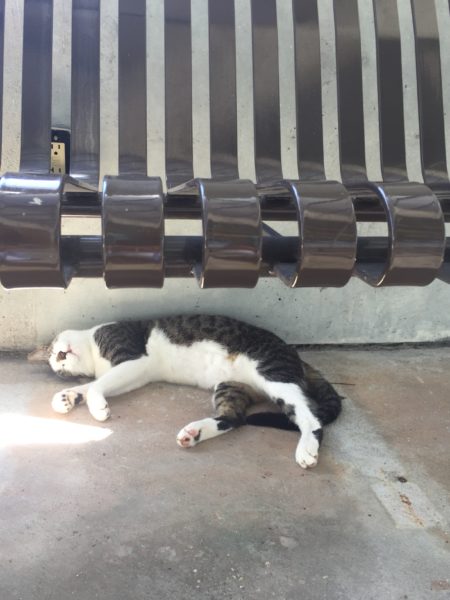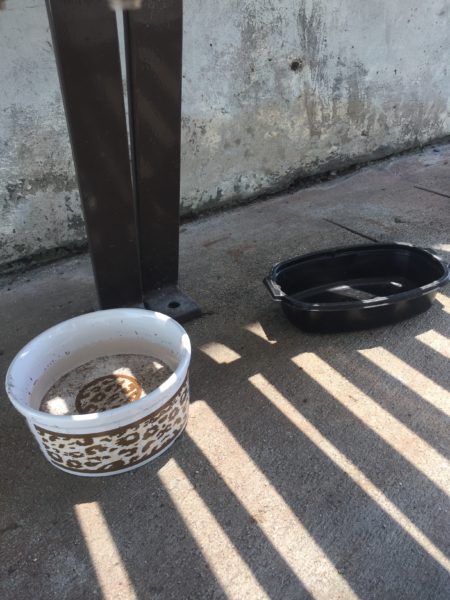Video by Brittany Moore and Audrey Carpenter
The stray cats on campus are part of UNF’s diverse wildlife, and the Department of Environmental Health and Safety wants to keep it that way.
Many students enjoy interacting with the stray cats that live on campus, but the department says students should be careful. There are stray and feral cats on campus, which according to Tod McVey, the department’s coordinator, are different.
“Stray cats end up being those cats that have been left outdoors but have some form of familiarity or domestication. Feral cats, on the other hand, are not,” McVey said.
He said strays may communicate with people by making eye contact, blinking or waving their tails, while feral cats will do the exact opposite.
“Feral cats will do everything to avoid you even running and hiding; if they come close to making eye contact they’re gone. They’ll crouch, they’ll curl up, and they’ll kind of walk away or try and find a place to hide,” McVey said.

Although the cats may seem like a problem, the department wants to keep them on campus.
McVey said the department wants to capture the feral and stray cats, spay and neuter them and clip their ears so they can be identified. They do this by setting out traps and waiting for the cats to come. McVey said this is their home, and it keeps the cat population down by keeping other feral cats from invading.
He warned students from feeding or getting too close to the cats that live on campus, saying that they should be treated the same as all the other wildlife on campus.

He said if students feed them, cats can become dependent on the food, which may not be consistent and could get eaten by the geese or other wildlife.
McVey said students can better help the cats by alerting the department.
“If you see a cat and you don’t know if it’s stray or feral, take a picture of it and send it to us. We would rather know about it and find a way to help it in some way or other.”
—
For more information or news tips, or if you see an error in this story or have any compliments or concerns, contact editor@unfspinnaker.com.












Charles Tinsley | Jan 6, 2020 at 1:11 pm
I can attest TNR does in fact work I have personally been involved with multiple cat colonies that now no longer exist because of TNR. one such colony was 115 cats strong and now 12 years later the five left.
Some of these people who post in the comments know nothing about what they’re talkin about They never dealt with TNR, they never dealt with a cat colony and most of them probably kill cats.
I know 4 fact that Bill Anastasia does kill cats he brags about it all over the internet. His facts about rabies left out one interesting fact. There has been no documented cases of cats giving humans rabies in 40 years. Cats only account for 7.6 percent of all rabies cases
Yvretta Carus | Jul 26, 2016 at 7:29 pm
Your headline “Campus cats are here to stay” indicates you are abandoning the mythical claim that “TNR can eliminate cat colonies.” TNR does not eliminate cat colonies; it perpetuates them. If TNR were an effective population control method, it would work on mosquitoes, including the species that carry Zika virus. But public health officials are not practicing TNR of mosquitoes. Instead they advocate eliminating standing water in which mosquitoes breed, larvicides, wearing long pants and long-sleeved shirts, not going outside at times when mosquitoes fly, genetic engineering of mosquitoes, and putting mosquito-eating fish in standing water, among other methods. TNR doesn’t control mosquitoes, and it doesn’t control cats.
Donna Nespoli | Jul 26, 2016 at 1:56 pm
All I have is a BS in zoology but at least I realize domestic cats are not part of “diverse wildlife”. They are non-native, invasive predators that kill native wildlife and should be removed to shelters for placement in homes or a humane euthanasia.
Kathleen | Jul 26, 2016 at 1:39 pm
For an institution of learning to make the ridiculous statement UNF has in this article and the video which have no basis in fact is beyond belief. I hope the parents of the students haven’t read this because if they do it may seriously reduce tuition payments and will most likely prompt them to remove their children from attending and seek an institution for their collage aged children where the policies adopted are based in proven fact not fantasy. I understand this university is in Florida but although Disneyworld is close not all the alumni will be seeking employment there after graduation even though it appears that staff must be spending much of its free time there as it appears to be influenced by fantasy.
Yvretta Carus | Jul 25, 2016 at 6:56 pm
House cats are descended from a kind of cat native to north Africa and the Middle East–not the Americas. Nothing like a house cat lived here before 1492. Our native wildlife did not evolve with house cats and are not able to protect themselves from house cats. Moreover, the house cat is as artificial an animal as a Holstein cow. The Holstein cow was bred to be a super milk producer–she produces far more milk than her calf needs. The house cat was bred over thousands of years to be a super predator and a super reproducer. And the house cats on UNF campus depend on food offered by humans. Every natural species of animal has a limiting factor, for example lack of food, disease, predation. The house cat’s wild ancestor was controlled by the jackal, a dog-like animal native to Africa. Bring in a few coyotes (a natural animal to North America, and rather like the house cat’s natural limiting factor), let them loose on campus, and stop feeding the stray cats. That will be a natural, biological solution to your cat problem.
Western ScrubJay | Jul 25, 2016 at 3:08 pm
In addition:
The health hazards associated with TNR also extend to
humans. As a result, the National Association of State
Public Health Veterinarians, Inc. does not support TNR
as a method of cat control and supports cat control
through removal from the wild and responsible ownership,
including keeping owned cats indoors.
Similarly,
the Florida Rabies Advisory Committee of the Florida
Department of Health also advocates removal of feral
cats. When feeding ceases, cat colonies disband, cat
densities return to a level more easily tolerated by
wildlife, and health hazards diminish.
Cat colonies and TNR are opposed by many groups
including: American Bird Conservancy, American
Association of Wildlife Veterinarians, American
Ornithologists’ Union, Cooper Ornithological Society,
National Association of State Public Health
Veterinarians, Association of Avian Veterinarians, The
Wildlife Society and the Florida Department of Health.
Reducing the Flow of New Cats
into the Wild
Any effort to control Florida’s cat problem should
include measures to reduce the flow of new cats into
the wild. Several steps can be taken at the municipal
or county level, the level at which laws are typically
implemented to control animals such as cats and
dogs.
Suggestions include:
• Mandatory licensing and tagging of cats.
• Encourage all pet adoption programs to require
new owners to spay/neuter their new pet and
provide rewards for spaying and neutering (i.e.,
lower licensing fees).
• Enactment and enforcement of “leash laws”
that require owners to restrict their pets to the
owner’s property unless under their direct
physical control.
• Support passage and enforcement of local
ordinances that prohibit abandonment and
feeding of stray cats. Post warning signs in public
areas set aside for wildlife announcing that
feeding and cat colonies are illegal.
• Prohibit feeding of stray cats in public lands that
serve as wildlife habitat.
Law Enforcement
FWC is charged with the regulation of wildlife, rather
than domestic species, and therefore must necessarily
depend upon county authorities with jurisdiction over
domestics to ensure that these species are properly
controlled. County authorities are urged to carefully
consider the long-term negative effects of authorizing
or sanctioning the release of domestic cats into urban
and rural areas
Western ScrubJay | Jul 25, 2016 at 2:44 pm
FWC scientists do not view trap neuter release and cat colonies as
an appropriate method for dealing with cat overpopulation.
Initiatives that include removal of feral cats
from the wild, euthanasia or adoption, methods that
reduce the flow of cats into the wild, and education
that informs the public about cats and how to minimize
their adverse impacts on wildlife are much better
options.
Johanna van de Woestijne | Jul 25, 2016 at 2:31 pm
Cats, stray or feral or pets, are all a domesticated species, like dogs. They are NOT wildlife, but rather more correctly, in ecological terms, an introduced species. When they reduce biodiversity, they are considered invasive. Feral cats, stray cats, free roaming cats are all NOT a part of the natural ecology in Florida and in fact do great harm to the biodiversity, ecosystems, and public health.
There is NOTHING humane or effective about trapping and releasing feral cats after neutering. It fails to reduce the feral cat populations overall and leaves the cats out to die INHUMANE deaths. Neutering also does NOT prevent feral cats and free roaming pet cats from KILLING the local native small mammals, birds, amphibians, and reptiles. Neuter release of feral cats is wishful thinking with religious zealotry of the cat nutters at its worst, with absolutely no scientific basis in reality. Is this what Florida university students should be learning about their ecology? A complete denial of the existence of the ecological sciences or science of infectious diseases? Worshipping the sacred nature of feral and free roaming cats really should NOT be a part of the college education.
A comprehensive program to eliminate feral and free roaming cats should be designed by ecologists and wildlife veterinarians, NOT cat nutters, who favor the continued existence of feral and free roaming cats over biodiversity and ecological balance. Campuses, parks, backyards, creeks, marshes, wildlife areas, watersheds are all mini-ecosystems and feral and free roaming cats reduce biodiversity and degrade public health in all these areas. A well cared for cat kept in a cat patio at home is the best situation. If students or administrators want cats, they should do so in the privacy of their own homes.
Public health issues are at stake, which is always conveniently denied by the cat right to lifers, who seem to wish death on all other species. Licensing and microchipping for pet cats and dogs alike would be a better place to start. But, that is opposed by the feral cat nutters, because animal control officers could know who the responsible party is for a cat caught in a wildlife area, or watershed, or schoolyard, or neighbors backyard, or on campus.
Through licensing requirements, dogs and cats alike could be required to be neutered prior to the first litter, as well as vaccinated appropriately, and required to be kept under control. Cat patios are wonderful for keeping cats safe, under control, and on the owners property.
The cat nutters advocating for trap neuter release make completely false and erroneous claims that it will reduce the feral cat population. Rarely are the feral cats fully trapped, usually reaching levels of only 5% at best, which leaves a large population of feral and free roaming cats able to breed and hunt vulnerable species, as they preferentially predate native species.
Neuter release of feral cats simply doesn’t work. It can actually can increase or sustain large populations of feral cats for decades at a time. It also encourages “hoarding without borders” in the great outdoors, in this case, on a campus. Often the cats end up in parks, playgrounds, other peoples private property and places of business, city property, and ecologically sensitive wildlife areas and watersheds. People see a cat and often they will feed them secretly, which also increases the population, because not all cats are neutered.
As to the supposed rabies protection, it NEVER happens. The medicals records aren’t kept up to date, no one is responsible for the cats, they are NOT microchipped and even if they are, they are extremely difficult to retrap and maintain in current vaccination status. Rabies vaccination is a series of three. The primary is at 2 to 4 months, booster at one year, and booster again at 2 to 3 years, depending on the manufacturer. Rabies can break out in feral cat colonies and put children and adults at risk, as they approach cats more easily than other wild rabid animals such as raccoons.
Cats shed multiple parasites, of which Toxoplasma gondii is only one. Neutering cats does NOTHING to prevent a continued spread of Toxo to humans and wildlife. It can cause miscarriages in humans, fetal developmental defects, and loss of vision and blindness, that can manifest in the first and second decades of life. Native felids in Florida have been fatally infected by feral cat diseases. Livestock meat and reproduction are degraded by infection with feral cat parasites. Don’t walk barefoot around feral cat areas, some of their parasites can enter through broken skin and even intact skin.
For control of feral cat populations, there has to be a comprehensive approach, including public education, shut down of backyard kitten and puppy mills, and strict removal with NO return policies of feral dogs and cats alike. Either the animals are adopted, kept under control and fully licensed, or euthanized. See the controls programs and information suggested here https://abcbirds.org/program/c…
Bill Anastasia | Jul 25, 2016 at 2:17 pm
Mr. McVay seems to lack even a basic understanding of biology and ecological systems. Feral and Stray cats are NOT wildlife. They are highly destructive, invasive, non-native, domesticated predators that wreak havoc on ecological systems where they have been introduced. Classifying them as being the same as our native flora and fauna which evolved here together for millions of years is not only woefully ignorant but dangerous.
Feral cats are the #1 domestic species responsible for rabies transmissions to humans, not to mention they are the definitive host of Toxoplasmosis Gondii which is the 2nd leading cause of food born illness resulting in almost 400 deaths per year. 60 Million people in the US are infected with the T. Gondii parasite which can ONLY be spread by cats.
Mr. McVay also seems to believe TNR’d feral cats are capable of keeping other cats out of the area, but anyone who is familiar with the scant data available for the vaccumme effect regarding feral cats knows that “…virtually no information exists to support the contention that neutering is an effective long-term method for controlling free-roaming cat populations.” “…free-roaming cats do not appear to have sufficient territorial activity to prevent new arrivals from permanently joining colonies.”Levy, Julie K., David W. Gale, and Leslie A. Gale. Evaluation of the Effect of a Long-Term Trap-Neuter-Return and Adoption Program on a Free-Roaming Cat Population. Journal of the American Veterinary Medical Association 2003, 222(1): 42-46.
The only thing in this article that makes any sense it to stop feeding the cats. Humans feeding cats will attract more cats, more cat abandoners, and more raccoons and opossums and skunks and all manner of TRUE WILDLIFE that we should allow to live free from human intervention. Feral and stray cats are man-made species that fill no ecological niche anywhere on earth. They belong contained and or indoors.
It appears the Department of Environmental Health and Safety at UNF should really take some time to understand the impact of feral and free-roaming cats. Allowing this behavior to persist is bad for wildlife, bad for public health and bad for the cats themselves. Unsocialized feral cats are no one’s companion. They are no different from feral dogs, feral hogs, feral burmese pythons, feral nutria, zebra mussels, or asian carp… We don’t advocate for TNR of those deleterious invasive animals, why cats?
Kyle Pias | Jul 25, 2016 at 1:52 pm
I’m guessing that UNF also recommends that its students not get vaccinated to avoid autism and encourages the burning of fossil fuels. Because TNR is in the same realm of bunk pseudo-science as the anti-vaccine movement and climate change denial. This is a discredit to an academic institution and shows a complete ignorance and lack of respect for the amazing wildlife and ecosystems of Florida.